
|
Video Papers
Download the slide set of all hot spot and video paper
presentations as a pdf file.
| | V01: Creating Ad-Hoc Pervasive Computing Environments |
| | |
Michael Beigl,
Tobias Zimmer,
Albert Krohn,
Christian Decker,
Philip Robinson (Univ. of Karlsruhe, Germany)
|
|
| |
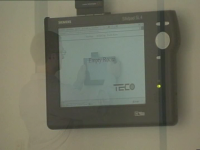 Pervasive Computing technology can convert everyday environments, such as office
spaces, into digitally enriched places. Users can profit from pervasive computing environments
in many ways: context aware applications may proactively react [4], leading to,
for example, information being displayed based on the useres current location. In bringing
more and more of these technologies together, the potential will rise yet the effort to keep
these systems running will increase. Today many approaches require a pre-installation of
technology and maintenance of the setting. In our vision such environments will not be
planned and installed by experts, but will emerge or even be assembled ad-hoc. This will
enable users, unfamiliar with computing technology in general and pervasive computing
technology in particular, to profit from such environments without the need for administration
and maintenance by others.
This paper introduces Impromptu, a concept that enables us to build pervasive computing
environments from scratch without the need for infrastructure and without expert knowledge
and configuration. Impromptu defines concepts and provides a framework with enabling
technology for creating systems that can later be used in Impromptu environments.
The Impromptu specifies a computing device that can be part of such an environment,
while the Impromptu framework provides technology that supports building technology
for Impromptu environments.
Pervasive Computing technology can convert everyday environments, such as office
spaces, into digitally enriched places. Users can profit from pervasive computing environments
in many ways: context aware applications may proactively react [4], leading to,
for example, information being displayed based on the useres current location. In bringing
more and more of these technologies together, the potential will rise yet the effort to keep
these systems running will increase. Today many approaches require a pre-installation of
technology and maintenance of the setting. In our vision such environments will not be
planned and installed by experts, but will emerge or even be assembled ad-hoc. This will
enable users, unfamiliar with computing technology in general and pervasive computing
technology in particular, to profit from such environments without the need for administration
and maintenance by others.
This paper introduces Impromptu, a concept that enables us to build pervasive computing
environments from scratch without the need for infrastructure and without expert knowledge
and configuration. Impromptu defines concepts and provides a framework with enabling
technology for creating systems that can later be used in Impromptu environments.
The Impromptu specifies a computing device that can be part of such an environment,
while the Impromptu framework provides technology that supports building technology
for Impromptu environments.
|
| | V02: Concept Video for a Context Aware Cell Phone |
| | |
Urpo Tuomela,
Mika P. Mustonen (Nokia Corporation, Finland)
|
|
| |
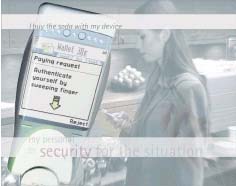 Context aware computing provides new possibilities for user interaction in personal
mobile communication. Future mobile terminals benefit from wide range of
communication and interaction methods enabling seamless ubiquitous communication
with interactive environment and other terminals. This paper presents the video of
context aware cell phone and its user interface/interaction (UI) concept. The
development of UI concept is based on the results of user-centric studies meaning, that
industrial design, user interfaces, user interaction and applications of the device are
dominated by end user needs.
Context aware computing provides new possibilities for user interaction in personal
mobile communication. Future mobile terminals benefit from wide range of
communication and interaction methods enabling seamless ubiquitous communication
with interactive environment and other terminals. This paper presents the video of
context aware cell phone and its user interface/interaction (UI) concept. The
development of UI concept is based on the results of user-centric studies meaning, that
industrial design, user interfaces, user interaction and applications of the device are
dominated by end user needs.
|
| | V03: Service Mobility Proxy for Seamless Handover between Various Devices |
| | |
Mikio Hasegawa,
Udana Bandara,
Masugi Inoue,
Khaled Mahmud,
Hiroyuki Morikawa (University of Tokyo, Japan)
|
|
| |
 Abstract. This video shows demonstrations of Cross-Device Handover using
the Service Mobility Proxy (SMP), which supports seamless handover between
various types of terminals of any service application. The SMP has functions
for switching the destination terminal and transcording. As the destination terminals,
we use PCs, PDAs, the Polycom TV conferencing system, etc. Moreover,
we have designed and implemented a very simple device, which we call
the Net Speaker as a destination terminal. It mainly consists of DA converter,
amplifier and Ethernet adaptor. It is a very simple network oriented device,
which can receive WAV formatted data and play it. In this video, we show
handover of videophone and streaming video applications among those devices.
Abstract. This video shows demonstrations of Cross-Device Handover using
the Service Mobility Proxy (SMP), which supports seamless handover between
various types of terminals of any service application. The SMP has functions
for switching the destination terminal and transcording. As the destination terminals,
we use PCs, PDAs, the Polycom TV conferencing system, etc. Moreover,
we have designed and implemented a very simple device, which we call
the Net Speaker as a destination terminal. It mainly consists of DA converter,
amplifier and Ethernet adaptor. It is a very simple network oriented device,
which can receive WAV formatted data and play it. In this video, we show
handover of videophone and streaming video applications among those devices.
|
| | V04: u-Photo: A Snapshot-based Interaction Technique for Ubiquitous Embedded Information |
| | |
Naohiko Kohtake,
Takeshi Iwamoto,
Genta Suzuki,
Shun Aoki,
Daisuke Maruyama,
Takuya Kouda,
Kazunori Takashio,
Hideyuki Tokuda (Keio University, Japan)
|
|
| |
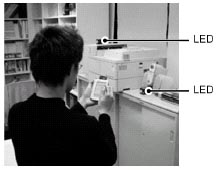 We present a snapshot-based direct interaction technique that enables to focus on particular
embedded information corresponded to each target object from a limitless number of ubiquitous
embedded information through actions of taking photos. With the proposed u-Photo which is
augmented image data, available icons of embedded information will be overlaid on a focused
target image when the u-Photo was taken and a user can operate networked appliances and monitor
sensor data within the focused area. Based on this concept, several applications for intuitive
interactions, remote operations and service reproductions have been implemented. We have
demonstrated that the u-Photo is quite useful media for exchanging and realizing an easy direct
interaction with various kinds of appliances.
We present a snapshot-based direct interaction technique that enables to focus on particular
embedded information corresponded to each target object from a limitless number of ubiquitous
embedded information through actions of taking photos. With the proposed u-Photo which is
augmented image data, available icons of embedded information will be overlaid on a focused
target image when the u-Photo was taken and a user can operate networked appliances and monitor
sensor data within the focused area. Based on this concept, several applications for intuitive
interactions, remote operations and service reproductions have been implemented. We have
demonstrated that the u-Photo is quite useful media for exchanging and realizing an easy direct
interaction with various kinds of appliances.
|
| | V05: Urban Tapestries: Public Authoring in the Wireless City |
| | |
Alice Angus, Giles Lane (Proboscis, UK)
|
|
| |
 Urban Tapestries is a framework for understanding the social, cultural, economic and political
implications of pervasive location-based mobile and wireless systems. To investigate these issues, we
are building an experimental location-based wireless platform to allow people to access and author
location-specific content (text, audio and pictures). It is a forum for exploring and sharing
experience and knowledge, for leaving and annotating ephemeral traces of peoplesg presence in the
geography of the city.
Urban Tapestries allows people to author their own virtual annotations of the city, enabling a
communityes collective memory to grow organically, allowing ordinary citizens to embed social
knowledge in the new wireless landscape of the city. People will be able to add new locations,
location content and the threadsn which link individual locations to local contexts, which are
accessed via handheld devices such as PDAs and mobile phones.
Urban Tapestries was conceived, initiated and is being developed by Proboscis.
It is a partnership with Hewlett-Packard Research Labs, Orange and the London School of Economics in
collaboration with France Telecom R&D, Locustworld and the Ordnance Survey.
The project has been funded by the Department of Trade and Industry, Arts Council England
and the Daniel Langlois Foundation for the Arts, Science and Technology with additional sponsorship
from Garbe UK, Apple Computer UK & Sony Europe.
Urban Tapestries is a framework for understanding the social, cultural, economic and political
implications of pervasive location-based mobile and wireless systems. To investigate these issues, we
are building an experimental location-based wireless platform to allow people to access and author
location-specific content (text, audio and pictures). It is a forum for exploring and sharing
experience and knowledge, for leaving and annotating ephemeral traces of peoplesg presence in the
geography of the city.
Urban Tapestries allows people to author their own virtual annotations of the city, enabling a
communityes collective memory to grow organically, allowing ordinary citizens to embed social
knowledge in the new wireless landscape of the city. People will be able to add new locations,
location content and the threadsn which link individual locations to local contexts, which are
accessed via handheld devices such as PDAs and mobile phones.
Urban Tapestries was conceived, initiated and is being developed by Proboscis.
It is a partnership with Hewlett-Packard Research Labs, Orange and the London School of Economics in
collaboration with France Telecom R&D, Locustworld and the Ordnance Survey.
The project has been funded by the Department of Trade and Industry, Arts Council England
and the Daniel Langlois Foundation for the Arts, Science and Technology with additional sponsorship
from Garbe UK, Apple Computer UK & Sony Europe.
|
| | V06: Smart Roads in the Pervasive Computing Landscape |
| | |
Volker Christian, Alois Ferscha, Wolfgang Narzt, Gustav Pomberger (University of Linz, Austria), Dieter Kolb, Reiner Müller, Jan Wieghardt (Siemens AG, Munich, Germany), Reinhold Bidner, Horst Hörtner, Christopher Lindinger (Ars Electronica Futurelab, Linz, Austria)
|
|
| |
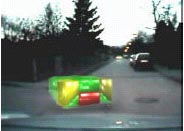 Physical objects capable of supplying computing services to users by utilizing hidden
pervasive computing technologies are considered to be smart. Allowing not only a
physical correspondence of object and enabling technology but also a logical one
substantially increases the set of real objects to be considered as smart.
This paper presents an innovative thought model of virtually smart things, i.e., objects
in the real world not physically equipped with sensory gadgets or interaction facilities,
but also being aware of their surrounding environment by their virtual representation.
The main focus of the following sections concentrates on a Smart Road, a fully implemented
use-case, telling its users where to go.
Physical objects capable of supplying computing services to users by utilizing hidden
pervasive computing technologies are considered to be smart. Allowing not only a
physical correspondence of object and enabling technology but also a logical one
substantially increases the set of real objects to be considered as smart.
This paper presents an innovative thought model of virtually smart things, i.e., objects
in the real world not physically equipped with sensory gadgets or interaction facilities,
but also being aware of their surrounding environment by their virtual representation.
The main focus of the following sections concentrates on a Smart Road, a fully implemented
use-case, telling its users where to go.
|
| | V07: Spotlight Navigation: Interaction with a Handheld Projection Device |
| | |
Stefan Rapp, Georg Michelitsch, Martin Osen, Jason Williams, Martin Barbisch, Ronan Bohan, Zica Valsan, Martin Emele (Sony Europe GmbH, Germany)
|
|
| |
 Abstract
This paper introduces a novel interaction paradigm for handheld devices using projection technology
that leverages real world experience by users. They can navigate naturally in unlimited virtual
information spaces with simple hand gestures, similar to using a flashlight. We describe interaction
techniques specifically designed for such devices that are intuitive, efficient and - as informal experimentation
with users has shown - fun to use.
Abstract
This paper introduces a novel interaction paradigm for handheld devices using projection technology
that leverages real world experience by users. They can navigate naturally in unlimited virtual
information spaces with simple hand gestures, similar to using a flashlight. We describe interaction
techniques specifically designed for such devices that are intuitive, efficient and - as informal experimentation
with users has shown - fun to use.
|
| | V08: Investigating Proyotypes Through Play |
| | |
Kristina Andersen (STEIM, The Netherlands)
|
|
| |
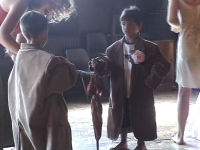 The video presents ensembleo a set of wireless sensor prototypes designed to be
investigated by children through play. It consists of a short technical overview and video
from one of the workshops where the children played with the prototypes. All output is
sound. The children are between 3 and 5 years old. They play independently and are
developing ways of using the interfaces themselves. The video is divided into areas of
discovery each with their own header. The children also spend time drawing the
prototypes and the video shows examples of this.
The video presents ensembleo a set of wireless sensor prototypes designed to be
investigated by children through play. It consists of a short technical overview and video
from one of the workshops where the children played with the prototypes. All output is
sound. The children are between 3 and 5 years old. They play independently and are
developing ways of using the interfaces themselves. The video is divided into areas of
discovery each with their own header. The children also spend time drawing the
prototypes and the video shows examples of this.
|
| | V09: Digital Aura |
| | |
Alois Ferscha, Manfred Hechinger, Rene Mayrhofer (Johannes Kepler Universität Linz, Austria), Marcos dos Santos Rocha, Marquart Franz, Roy Oberhauser, (SIEMENS Munich, Germany)
|
|
| |
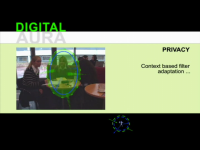 Smart space and smart appliances, i.e. wirelessly ad-hoc networked, mobile, autonomous
special purpose computing devices, providing largely invisible support and contextaware
services have started to populate the real world and our daily lives. In such a
world, where literally everything is connected to everything with invisible, wireless data
links, we need new styles on how humans and things can interact. We have proposed a
"spontaneous interaction" thought model, in which things start to interact once they
reach physical proximity to each other: Explained using the metaphor of an "aura",
which like a subtle invisible emanation or exhalation radiates from the center of an
object into its surrounding, a "digital aura" is built on technologies like Bluetooth radio,
RFID or IrDA together with an XML based profile description, such that if an object
detects the proximity (e.g. radio signal strength) of another object, it starts exchanging
and comparing profile data, and, upon sufficient "similarity" of the two profiles, starts to
interact with that object. A "digital aura" depending on the implementation technology,
is dense in the center of the object, and thins out towards its surrounding until it is no
longer sensible by others. Profiles described as semi-structured data and attached to the
object, can be matched by a structural and semantic analysis. Peer-to-peer concepts can
then be used to implement applications on top of the digital aura model for spontaneous
interaction.
Smart space and smart appliances, i.e. wirelessly ad-hoc networked, mobile, autonomous
special purpose computing devices, providing largely invisible support and contextaware
services have started to populate the real world and our daily lives. In such a
world, where literally everything is connected to everything with invisible, wireless data
links, we need new styles on how humans and things can interact. We have proposed a
"spontaneous interaction" thought model, in which things start to interact once they
reach physical proximity to each other: Explained using the metaphor of an "aura",
which like a subtle invisible emanation or exhalation radiates from the center of an
object into its surrounding, a "digital aura" is built on technologies like Bluetooth radio,
RFID or IrDA together with an XML based profile description, such that if an object
detects the proximity (e.g. radio signal strength) of another object, it starts exchanging
and comparing profile data, and, upon sufficient "similarity" of the two profiles, starts to
interact with that object. A "digital aura" depending on the implementation technology,
is dense in the center of the object, and thins out towards its surrounding until it is no
longer sensible by others. Profiles described as semi-structured data and attached to the
object, can be matched by a structural and semantic analysis. Peer-to-peer concepts can
then be used to implement applications on top of the digital aura model for spontaneous
interaction.
|
|

